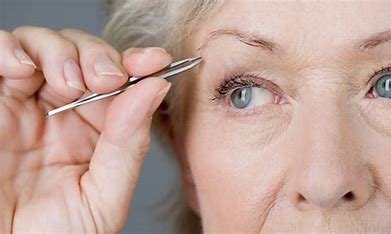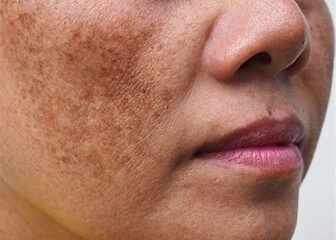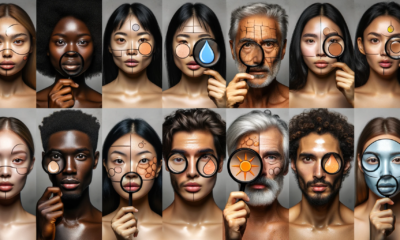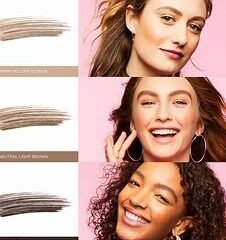Brow Styling
How Often Should Eyebrows Be Plucked

They say that 'less is more,' and this adage holds true when it comes to plucking your eyebrows. To maintain a well-groomed appearance, it is recommended that you pluck your eyebrows every 3-4 weeks.
By doing so, you can keep them looking neat and tidy, without going overboard. Plucking them too frequently can lead to sparse brows, while waiting too long can result in unruly and overgrown eyebrows. Finding the right balance is key.
So, take a moment to assess the shape of your eyebrows and give them a gentle pluck when needed. By following this regular maintenance routine, you can achieve the desired shape and keep your eyebrows looking their best.
Key Takeaways
- The growth cycle of eyebrow hair consists of three stages: anagen, catagen, and telogen.
- The ideal plucking frequency depends on the rate of eyebrow growth and the desired shape.
- Professionals recommend scheduling a hair removal session every two weeks, with eyebrow threading being a popular method.
- Avoid common mistakes such as over-plucking, plucking too close to the brow line, and neglecting to trim long eyebrow hairs.
Factors Affecting Eyebrow Growth Rate
You should understand the factors that can affect how frequently your eyebrows need to be plucked. The rate at which your eyebrow hair grows plays a significant role in determining how often you need to pluck them.
Each hair follicle on your eyebrows goes through a growth cycle that consists of three stages: anagen, catagen, and telogen. The anagen phase is the active growth stage, where the hair follicle is producing new hair. This phase can last anywhere from two to six weeks, depending on various factors such as genetics and age.
After the anagen phase, the catagen phase begins, which is a transitional stage where the hair follicle shrinks and detaches from the blood supply. This phase lasts for about two weeks. Finally, the telogen phase is the resting phase where the old hair falls out, making room for new hair to grow. This phase can last for six to eight weeks.
Therefore, considering the duration of each phase, it's recommended to pluck your eyebrows every four to six weeks to maintain their shape and prevent unruly hair from growing out.
How to Determine Your Ideal Plucking Frequency
To determine your ideal plucking frequency, consider the rate at which your eyebrows grow and the desired shape you want to maintain. Understanding the natural growth cycle of your eyebrow hair is essential in determining how often you should pluck your eyebrows. On average, it takes about 4-8 weeks for brows to start growing. Therefore, it's recommended to wax or pluck when all the hairs have reached the same length.
If you want to maintain a well-groomed appearance, most professionals suggest visiting every 5-6 weeks for waxing. This timeframe allows your brows to fully develop before the next plucking session. However, if you want to avoid overplucking, which can lead to sparse or odd-shaped brows, consider waxing every 3-4 weeks instead.
It is important to resist the temptation to pluck between appointments. Plucking disrupts the hair growth cycle and can undo the professional shaping work done during your visit. Instead, use makeup to fill in your eyebrows and incorporate stray hairs into the desired shape.
Professional Recommendations for Eyebrow Maintenance
After considering the rate of your eyebrow hair growth and the desired shape you want to maintain, it's important to follow professional recommendations for maintaining well-groomed brows. To keep your brows looking their best, it's generally advised to schedule a hair removal session every two weeks. This ensures that any new growth is effectively managed and prevents your brows from becoming unruly.
One popular method of hair removal is Eyebrow Threading. This technique involves using a twisted thread to remove individual hairs from the root. It's a precise and efficient method that allows for the creation of well-defined and symmetrical brows. Many professionals recommend Eyebrow Threading every two weeks to maintain the desired shape and prevent any stray hairs from disrupting the overall appearance.
Following professional recommendations for eyebrow maintenance is essential for achieving and maintaining well-groomed brows. By adhering to a regular schedule of hair removal, such as every two weeks, you can ensure that your brows always look their best. Whether you choose Eyebrow Threading or another method, consistency is key to maintaining the desired shape and achieving a neat and polished look.
Common Mistakes to Avoid When Plucking Eyebrows
To avoid common mistakes, it's important to be mindful of how often you should pluck your eyebrows. One common mistake is plucking stray hairs too frequently. It's tempting to pluck every time you notice a stray hair, but this can lead to over-plucking and thinning of your eyebrows. Instead, try to resist the urge and only pluck stray hairs when they become noticeable and start to affect the overall shape of your eyebrows.
Another mistake to avoid is plucking too close to the brow line. When you pluck too close, you risk creating gaps in your eyebrows. It's best to leave a small buffer zone and avoid plucking hairs that are too close to the natural brow line. This will help maintain the fullness and shape of your eyebrows.
Additionally, neglecting to trim long eyebrow hairs can result in an unkempt appearance. Trimming your eyebrows regularly will help keep them looking neat and tidy. Use a small pair of scissors and trim any hairs that are noticeably longer than the rest.
Lastly, using dull or improper tweezers can cause unnecessary pain and breakage. Invest in a good pair of tweezers with a sharp, slanted tip for better precision and control. This will make the plucking process easier and more comfortable.
Signs That Your Eyebrows Need to Be Plucked
If you notice stray hairs disrupting the natural shape of your eyebrows, it's time to pluck them. Maintaining the natural shape of your eyebrows is important for a polished and put-together appearance. To help you identify when it's time to pluck, here are some signs to look out for:
| Signs That Your Eyebrows Need to Be Plucked | ||
|---|---|---|
| Visibly Overgrown Hairs | Unkempt Appearance | Obscured Natural Arch |
| When hairs become visibly overgrown and extend beyond the brow line, it's a sign that plucking is needed. Keeping your brows neat and tidy is a good idea for a well-groomed look. | ||
| If your eyebrows start to look unkempt or untidy, it's a clear indication that plucking is necessary. Stray hairs can make your brows appear messy, so make sure to remove them. | ||
| When the natural arch of your brow becomes obscured by excess hair, it's a sign that plucking is overdue. Reclaiming the defined shape of your brows will enhance your facial features. | ||
| If your eyebrows lose their defined shape and symmetry, it's a clear signal that plucking is required. Maintaining the natural shape of your brows will frame your face beautifully. |
Tips for Maintaining Well-Groomed Eyebrows Between Plucking Sessions
When it comes to maintaining well-groomed eyebrows between plucking sessions, there are a few tips that can help you achieve the desired look. First, make sure to brush over any stray hairs with a highlighter. This will help you easily identify and remove any unwanted hair that may have grown since your last plucking session. Additionally, using a brow razor can give you a shaggy chic look while still maintaining well-groomed eyebrows. However, be cautious and avoid tugging at the root to prevent any damage to your brows.
To keep your eyebrows looking natural and well-maintained, break down any product buildup by using a clean mascara brush. This will help give your brows a more natural finish in between plucking sessions. Embracing fuller brows is also a great option, as they're currently in trend and can enhance your facial features. Remember, fuller brows can frame your face beautifully.
Lastly, when it's time for a touch-up, always use tweezers to pluck your eyebrows. Tweezers offer more control and precision compared to other hair removal methods, ensuring that you achieve the desired shape and thickness. By following these tips, you can maintain well-groomed eyebrows between plucking sessions and achieve the perfect frame for your face.
Frequently Asked Questions
Is It Healthy to Pluck Eyebrow Hairs?
Plucking eyebrow hairs can disrupt the growth cycle and lead to sparse brows. Instead, embrace fuller brows and use makeup to fill in and shape them. Trust the waxing process and avoid excessive plucking between appointments.
How Often Do You Need to Get Your Eyebrows Tweezed?
You should tweeze your eyebrows every 4-6 weeks to maintain their shape. Avoid plucking between appointments to avoid disrupting hair growth. Tweezing every 2-3 days at home can help maintain the shape.
How Long Do Plucked Eyebrows Last?
Plucked eyebrows typically last for 4-6 weeks before regrowth. It's important to allow enough time for them to grow back before waxing. Avoid plucking between appointments to avoid disrupting the hair growth cycle.
Is Eyebrow Plucking Harmful for Eyes?
Plucking your eyebrows can be harmful to your eyes if done incorrectly. It's important to follow proper technique and not pluck too close to the brow line to avoid discomfort and potential damage.
Conclusion
In conclusion, maintaining the shape and neatness of your eyebrows requires regular plucking every 3-4 weeks. Finding the right balance is key to avoid sparse or overgrown brows.
It's important to consider factors affecting eyebrow growth rate and determine your ideal plucking frequency. Following professional recommendations and avoiding common mistakes will help achieve well-groomed eyebrows.
Keep an eye out for signs that indicate when your eyebrows need to be plucked and maintain their appearance between plucking sessions for a polished look.
Brow Care
Will Plucking Gray Eyebrows Make Them Thicker?

As you navigate the silver-lined journey of aging, you might’ve heard the old wives’ tale that plucking a gray eyebrow hair invites a party of replacements. However, this is simply a myth. When you pluck a gray hair, you’re only removing the individual hair strand; you’re not prompting the follicle to produce more.
It’s essential to understand the natural cycle of hair growth to effectively serve those concerned about their changing appearance. By debunking this misconception, you can confidently assist others in maintaining their grooming routines without fear of exacerbating gray hair growth.
In truth, each hair follicle acts independently, and plucking does not affect the color or quantity of hairs that will subsequently emerge.
Key Takeaways
- Plucking gray eyebrow hairs does not cause more to grow back.
- Plucking can traumatize the hair follicle, leading to inflammation or infection.
- Continuous or repeated plucking can result in scar tissue and sparse eyebrows.
- Seeking professional advice for gentle and effective solutions is recommended.
Debunking the Myth
Myth: you’ll spawn multiple grays by plucking just one, but this is a mere hair tale. You might’ve heard this warning and hesitated before pulling out one gray hair, fearing an army of silvers might take its place. It’s a common belief that plucking gray hairs will cause more to grow, yet science tells us this isn’t the case.
When you find that first gray hair, it’s an experience many might tell you to leave untouched. Plucking gray hairs doesn’t signal your follicles to replace it with more grays. Gray hair emerges because pigment cells in your follicles gradually diminish over time. It’s a natural, inevitable process, not a consequence of your grooming habits.
Yet, while plucking won’t cause more grays to sprout, it’s still not the best idea. You can actually harm the hair follicle, risking infection or scarring, which may lead to bald patches – certainly not the outcome you’re aiming for when you’re dedicated to nurturing and serving others through personal care.
The compassionate course is to embrace the transition or explore hairstyles and products that celebrate your evolving look. Care for each strand as you’d cherish the individuals you serve, with kindness and without false pretenses.
Understanding Hair Growth
Understanding the physiology of hair growth is crucial as you navigate the changes in your eyebrows’ coloration. Each hair on your body grows from its own individual hair follicle. As you age, the pigment cells in your follicles gradually die, which leads to your hair turning gray or white.
When you pluck hairs, especially those that are gray, it’s important to realize that you’re not just removing a hair; you’re interacting with the follicle. Although plucking a hair will indeed make room for a new one, the color of the new hair is determined by the health and pigment-producing capacity of that follicle. If it’s already producing gray hairs, the new hair will likely be gray as well.
Below is a table outlining the stages of hair growth:
| Stage | Description |
|---|---|
| Anagen | The active growth phase where hair fibers are produced. |
| Catagen | A transitional phase where growth stops and the follicle shrinks. |
| Telogen | The resting phase before the hair falls out naturally. |
| Exogen | The shedding phase where hair is released from the follicle. |
Causes of Graying Eyebrows
Why do your eyebrows start to show those pesky gray hairs as you age? It’s all down to the pigment cells in your hair follicles. These cells are responsible for your hair color, but as you grow older, they gradually die off. This reduction in pigment cells means less melanin, which is what gives your hair its color. Without enough melanin, new hairs grow in lighter, eventually turning gray or white.
Your genes play a big part in this process, so if your family members started showing gray hair at an early age, chances are you might too. Although graying is a natural part of aging, the exact time and pattern in which you’ll notice those silver strands can vary widely.
It’s important to treat your changing hair with care. Plucking might seem like a quick fix, but it can actually harm the follicle, lead to scarring, and even cause bald patches. Instead, consider trimming gray hairs carefully or embracing the natural transition. Seeking professional advice might also provide you with options that help you serve others with confidence, no matter the color of your eyebrows.
Consequences of Plucking
Plucking your gray eyebrow hairs doesn’t cause more to grow back, but it can lead to other unwanted consequences. When you remove these hairs, you might inadvertently traumatize the hair follicle. This trauma could result in inflammation or even infection, which certainly isn’t something you’d want for those you care for. You’re aiming to help them look and feel their best, not contribute to discomfort or potential harm.
Continuous or repeated trauma to the hair follicles from plucking can eventually lead to scar tissue. Over time, this can result in sparse eyebrows or bald patches where hair no longer grows. It’s a situation best avoided, especially for those who value a well-groomed appearance.
Instead of plucking, consider carefully cutting the gray hairs. This method is far less likely to traumatize the follicle, maintaining the integrity of the eyebrows. If you’re unsure about the best approach, seek professional advice. Aesthetic specialists can offer gentle, effective solutions for managing gray hairs without the risks associated with plucking.
Alternatives to Plucking
Considering alternatives to plucking, you’ll find trimming and embracing your gray eyebrow hairs are both effective and less harmful options. When opting for trimming, use small, sharp scissors to carefully cut each hair to the desired length. This method allows you to shape and maintain your eyebrows without risking hair loss or damage to the follicles.
If you’re uncomfortable with gray hairs and prefer a more uniform look, hair dye is a safe alternative. Select a color that closely matches your natural or desired shade, and apply it according to the product’s instructions. This can give you a refreshed appearance and help to blend the gray hairs seamlessly with the rest of your eyebrows.
Embracing gray hair can be a liberating choice. It’s a natural part of aging, and many find confidence in showcasing their silver strands. Rather than seeing it as a sign of getting older, consider it a badge of experience and maturity. By accepting your grays, you serve as an example to others, encouraging them to feel comfortable with their natural beauty.
Each of these options allows you to address gray eyebrow hairs with care and compassion, showing reverence for your body’s natural aging process.
Maintaining Gray Eyebrows
Maintaining your gray eyebrows with regular grooming practices ensures they complement your natural beauty without the risks associated with plucking. When you’re caring for gray or white brows, it’s all about enhancing what you have and avoiding any potential damage. Remember, plucking a gray hair might seem like a quick fix, but it can lead to more significant issues like infection or even bald patches. Instead, focus on gentle care and subtle enhancements.
To hook your audience and give them practical advice, consider including these tips in your content:
- Trimming: Use a small pair of eyebrow scissors to trim long hairs carefully.
- Tinting: Opt for a professional eyebrow tint to give lighter brows a fuller appearance.
- Styling: Employ clear or tinted brow gel to shape your eyebrows and keep them in place.
- Filling in: Use a brow pencil or powder that’s one shade lighter than your hair color for a natural look.
- Nourishing: Apply a brow serum to keep the hair healthy and promote growth.
Frequently Asked Questions
Do More Gray Hairs Come Back if You Pluck Them?
You’ve heard it wrong; plucking gray hairs won’t make more sprout. But you’ll get the same color back, and it’s risky—you might end up with infection or bald spots, so trim carefully instead.
Should You Pluck GREY Eyebrow Hairs?
You shouldn’t pluck grey eyebrow hairs; it’s risky and can cause damage. Trim them instead or embrace your natural beauty to serve as an example of confident aging for others.
Why Should You Not Pluck Gray Hairs?
You shouldn’t pluck gray hairs because it can harm the follicle, risking infection, scarring, and bald spots. Instead, trim or embrace the grays, enhancing your natural beauty while serving others.
Will GREY Eyebrow Hairs Grow Back?
Yes, your gray eyebrow hairs will grow back, but they won’t multiply due to plucking. Be careful, as over-plucking can damage follicles and potentially reduce hair regrowth over time.
Conclusion
You’ve likely heard the old wives’ tale that plucking gray eyebrow hairs will just make more pop up. Well, you can toss that myth out the window. Science confirms that yanking those grays won’t summon more.
If you’re worried about the effects of plucking, rest easy; it doesn’t speed up graying or damage nearby hairs. Embrace your natural beauty, but if you prefer, pluck away or explore other grooming methods to keep your brows looking sharp.
-

 Skin Care2 years ago
Skin Care2 years agoSkin Care Products That Diminish Hyperpigmentation
-

 Skin Care2 years ago
Skin Care2 years agoUltimate Guide to Identifying Your Skin Type
-

 Brow Care2 years ago
Brow Care2 years agoWhy Brow Gels Can Cause Brows to Fall Out
-

 Brows2 years ago
Brows2 years agoHow to have Thicker Eyebrows
-

 Homemade Beauty2 years ago
Homemade Beauty2 years agoRecipes for Homemade Facials
-

 Skin Care2 years ago
Skin Care2 years agoMorning and Night Skincare Routines for Various Skin Concerns.
-
Waxing2 years ago
Tools for at Home Waxing
-

 Hair-Styling2 years ago
Hair-Styling2 years agoEasy Hairstyles for Busy Mornings.





xmc.pl
September 14, 2025 at 12:36 pm
You’ve managed to capture something ineffable — your words touch a place that logic alone cannot reach.